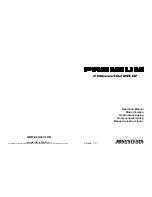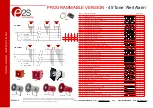
55M4300CCE00 Rev A
Step #13: Main boom “No Load calibration”
3
important checks before proceeding with each No Load calibration:
1.
Ensure that all previous sections have been completed, in particular that all
dimensions have been entered correctly and all sensors are correctly calibrated.
2.
Ensure that no ‘load adjustment’ factor is applied, go to the Load adjustment
calibration (section 3.7) and check that the adjustment value is 1.00. If
necessary follow the instructions in this section to set the value to 1.00 for the
current configuration, a test load is not required for this.
3.
Ensure that no ‘load correction’ calibration points have been set, go to the Load
correction calibration (section 6) and check that the next point offered is point 1,
if necessary follow the instructions at the end of section 6 to delete all the load
correction points for the current configuration.
The No load calibration procedure must be carried out for each of the Boom Mode
configurations to record the empty boom weight. For example a separate no-load
calibration needs to be done for main boom with the manual section in, and the manual
section out.
For machines with more than one length sensor where multiple no load calibrations are
done the system will continue to monitor the temporarily non-telescoping section(s) to
ensure it is not moved. If a change is detected then the calibration will be suspended
until the situation is corrected.
For all other configurations using the same main Boom Mode but with an attachment
fitted (i.e. main boom + jib stowed, main boom + jib erected, lifting over jib, etc…) no
other no load calibration is necessary. The system will calculate the load on the hook in
use making allowance for the fitted attachment using the weight and center of gravity
of the attachment already stored in memory.
For any given basic Boom Mode calibration it is essential that all unnecessary stowed
attachments are removed from the boom to ensure correct performance. Only the
main block should be rigged during a no load calibration and no jibs should be fitted or
stowed, including rooster sheave assemblies. Refer to the duty list to determine the
appropriate configuration for no load calibration and to the system configuration
section of the Instruction manual.
The crane needs to be rigged for each of these main boom conditions and the
appropriate duty needs to be selected before starting this procedure. Since this also
applies to unloaded and loaded boom deflection calibrations, it is recommended to do
both no-load and boom deflection calibrations while the machine is rigged on one
particular condition to save time.
Summary of Contents for i4300
Page 2: ...55M4300CCE00 Rev A ...
















































